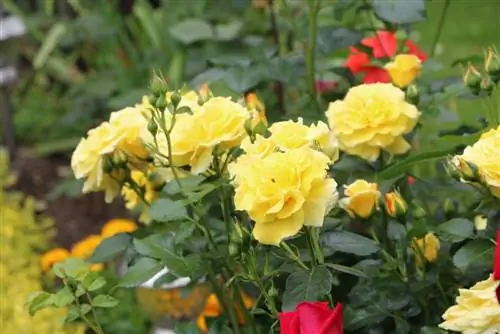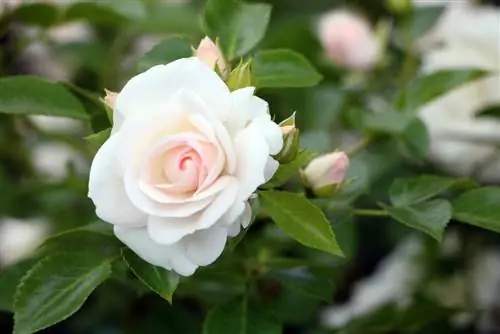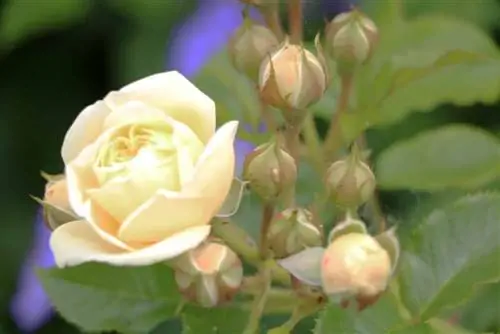- Author admin [email protected].
- Public 2023-12-17 03:39.
- Last modified 2025-01-24 12:45.
Because the production of new shoots, flowers and fruits (seeds) in the summer season is only part of the rose's life and work. Winter time is at least as important. The plant needs and uses this time to allow the summer shoots to mature and to strengthen the entire supply system so that there is enough strength for next year's growth. You can help your roses overwinter with the following measures:
Tips for overwintering outdoor roses
Shrub roses should no longer be fertilized after flowering and should only be sent into the winter with a special fertilizer in September, when the first leaves are just beginning to fall: They will then receive a dose of potassium-based fertilizer with as little nitrogen as possible and otherwise only contains a little phosphate. Nitrogen promotes growth, but you don't want to stimulate new shoots now, you just want to give the ones that have already started time to mature sufficiently by winter. To do this, they need a little phosphate, and otherwise, as winter preparation, above all potassium, which strengthens the plant cells overall and makes your roses resistant to cold and winter pests.
Then they can go into the winter in full foliage. It is often recommended to cut the shrub roses down to two thirds in autumn. However, the sole reason for this recommendation is to prevent pests from overwintering in the shoot tips, and it also has disadvantages: If you cut just a little too late or are surprised by an early onset of winter, the cuts on your shrub roses will no longer be able to heal properly would go into the winter unprotected in important areas.
You should pay close attention to whether your shrub rose shows any pest infestation that might need to be controlled in late summer. Of course, you can only cut back individual shoots that are excessively long.
If the shrub rose has withdrawn its food reserves into the trunk and lost its leaves, you should treat it to winter protection. The delicate crown can be protected from the cold wind with a coat of coniferous branches, the lower area is piled up with soil so high that the grafting area is completely covered and then covered with bubble wrap, coconut mat or straw.
Overwintering standard roses
The standard roses are prepared for the winter in the same way as the shrub roses when it comes to fertilizer.
Freely planted standard roses are often very sensitive to cold, so they should be particularly well protected. In the lower area you get the cover described above, and the entire trunk should also be completely wrapped with a suitable material (straw and plucking, bubble wrap, coconut mat). With standard roses, the grafting point is directly under the crown - so it is not protected by piling up in the root area.
The entire crown of a standard rose can also be poorly covered. It will also be packed up. To do this, you can either use a special film from the store or simply pack the entire crown in a jute bag.
If your standard rose is still very young and has a correspondingly flexible trunk, you can simply place it completely on the ground for the winter break. You then cover the entire rose, especially the entire crown, very lightly with soil, over which a little brushwood or mulch can be added.
Overwintering roses in pots or containers
When it comes to roses in pots or containers, the main thing is to protect them from drying out. Always remember that once the soil is frozen, water can no longer be transported through the roots. However, since the potted rose only has a smaller area of soil to fall back on, it dries out much more quickly than the rose outdoors.
So you have to prevent the soil in the pot from freezing completely, which can be achieved using several strategies. If you have the opportunity, the roses will move into a damp and bright room over the winter, which does not have to be completely frost-free if the pots are packed well. This can be a cellar with a window, a garage or a shed; an unheated greenhouse is of course also suitable. The potted rose then needs to be watered throughout the winter.
You can also place your potted rose in a particularly protected place outdoors over the winter where it gets enough light. For example, in the protection of a house wall, where it is not directly exposed to the sun. The pot must definitely be wrapped well, with bubble wrap or with several layers of fleece or with coconut mats, so that frost cannot penetrate the entire pot.

Remember to insulate the pot well at the bottom, for example. B. place on a piece of insulation mat that is left over from the facade insulation.
Alternatives
A sturdy plant trolley, perhaps covered with a few layers of coconut matting, or another transport trolley whose base is at a distance from the earth and can be covered with insulating material.
The soil is also piled up in the pot, and the container rose should also be prepared for the winter with special fertilizer. Now is also the right time to transplant, because it is also important that the planter is large enough: the more generous it is, the less likely it is that the entire root area will freeze.
Conclusion of the editors
Whether you prefer to have your roses in a bed or in a pot on the terrace - with a few thoughts about proper care, all roses will survive the winter well and will delight you even more with their flowers next spring!
- It's not just for potted roses that you have to be careful not to let your roses dry out. Outdoor roses also suffer from shortages when winter brings long periods of persistent cold and dry weather. This is e.g. This is the case, for example, when the wind comes from the east for a long time because there is a high pressure area over Eastern Europe. Then you should give your roses water, even in winter, even in frosty temperatures.
- Please never use plastic bags that do not allow air to pass through to pack your roses! Under such a plastic hood, the air warms up as if your rose was standing in a sunlit greenhouse. This would cause it to sprout far too early when there is a lot of sun, but then it would suffocate because it doesn't get any air.
- Rather, the protection is intended to prevent the roses from starting to sprout very early in the spring. You can easily achieve this by leaving the winter protection on the roses until the last late frosts are definitely over - i.e. until the end of April or until the ice saints in mid-May, depending on the region.
- Today there are protective covers for the crowns of your roses, which are also useful as winter decorations. Real fun for children is e.g. B. winter protection with the winter farm, which is offered by Videx Meyer-Lüters GmbH & Co. KG from 27204 Bassum. These protective hoods decorate the crowns with a series of funny animal faces. With tools like these, the children will definitely be happy to help pack the roses!






